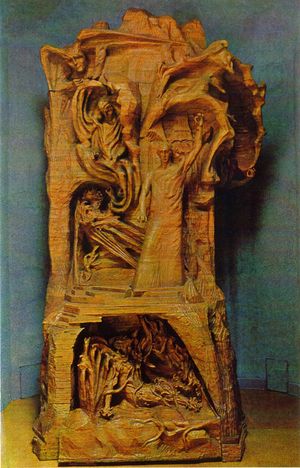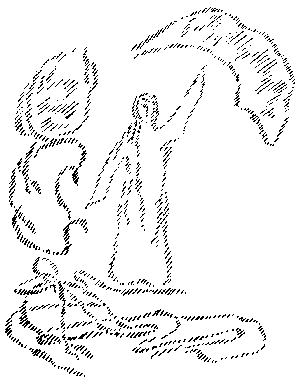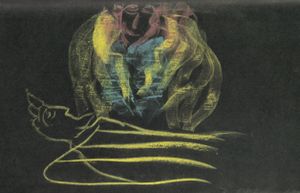The Representative of Humanity between Lucifer and Ahriman

The Representative of Humanity between Lucifer and Ahriman is a wooden sculpture more than 8 m high designed by Rudolf Steiner and created together with the sculptor Edith Maryon for the first Goetheanum in Dornach. It was to be placed in the small domed room, the stage room of the first Goetheanum. When the Goetheanum burned down on New Year's Eve 1922/23, the sculpture had not yet been completed and was therefore spared from the fire.
The striving of the individual human being for balance
„The people of the present day have a great need to place Christ in the midst of Ahriman and Lucifer. Christ-power must permeate us. But as human beings we must always seek the balance between that which, in a certain sense, mystically and enthusiastically wants to rise above us, and that which wants to pull us down to the earth in a materialistic, rational, philistine and difficult way. And if we endeavour to seek this balance, then alone can we find the Christ.“ (Lit.:GA 195, p. 40)
„I would like to say, I explain it to almost everyone of whom I only believe that he can have some understanding, to everyone who comes before the well-known wooden group in Dornach: "Christ in the middle as representative of humanity, Ahriman and Lucifer on either side", that the human being as we have him before us can really only be imagined by imagining everything about him as a state of equilibrium. On the one side is the supersensible, on the other the sub-sensible. The human being actually always represents only the state of equilibrium between the supersensible and the sub-sensible.“ (Lit.:GA 324a, p. 152)
„Until the middle of the 15th century, the single, individual human being did not come into consideration as he has since that time. Since that time, what is most essential in the human being is the striving to be individuality, the striving to unite individual personality forces, to find, as it were, a centre in oneself [...]
Through this, however, something becomes particularly important for man in this time, which began in the middle of the 15th century and will only end towards the fourth millennium. With this, something occurs that is of very special importance for this time. For you see, something vague is expressed when one has to say: Every human being strives for his own particular individuality. The group spirit, even if it comprises only smaller groups, is something much more tangible than that which each individual strives for out of the primal source of his individuality. Hence it is that it becomes especially important for this man of the newer times to understand what may be called the balance between the opposite poles: To seek a balance between the opposite poles.
The one wants to go beyond the head, so to speak. Everything that leads man to be a dreamer, a fantasist, a maniac, that fills him with indefinite mystical impulses towards some indefinite infinite, yes, that fills him even if he is a pantheist or a theist or something like that, which is so often the case today, that is the one pole. The other pole is that of sobriety, of dryness, trivially speaking, but not unrealistically speaking in relation to the spirit of the present, truly not unrealistically speaking: the pole of philistrosity, the pole of philistinism, the pole which draws us down to earth into materialism. These two poles of force are in the human being, and between them the human being stands, it has to seek the balance. In how many ways can one seek balance? [...]
In an infinite number of ways you can seek balance. This corresponds to the infinitely many ways of being an individual human being. That is why it is so essential for the present human being to realise that his being consists in the search for balance between the opposite poles. And the indeterminacy of the search for balance is precisely that indeterminacy of which I spoke to you earlier [...]
We are mentally healthy when we find the balance between the rapturously fantastic and the dryly philistine. We are physically healthy when we can live in balance between the fever and the sclerosis, the ossification. And this can happen in an infinite number of ways, in which individuality can live.
That is the way in which man, especially in modern times, must feel the old Apollo saying "Know thyself". But "know thyself" not in some abstraction: "Know thyself in the striving for balance." That is why we have to set up in the east of the building that which can make man feel this striving for balance. And this is to be represented in the sculptural wooden group mentioned yesterday, which has as its central figure the figure of Christ, the figure of Christ, which has been attempted to be shaped in such a way that one can imagine it: This is how the Christ really walked in the man Jesus of Nazareth at the beginning of our era in Palestine. The conventional images of the bearded Christ are actually creations of the 5th and 6th centuries, and they are truly not in any way, if I may use the expression, true to the portrait. That is what has been attempted: to create a Christ who is true to the portrait, who is at the same time supposed to be the representative of the searching human being, the human being who strives for balance. (It is drawn).

You will then see two figures at this group: Here the falling Lucifer, here the ascending Lucifer. Here below, in a certain sense connected with Lucifer, an Ahrimanic figure, and here a second Ahrimanic figure. The representative of humanity is placed between the ahrimanic figure: the philistine, the sober-dry-materialistic; and the luciferic figure: the rapturous, fantastic. The Ahriman figure: all that leads man to petrification, to sclerosis; the Lucifer figure: representation of all that leads man feverishly beyond the measure of that health which he can bear.“ (Lit.:GA 194, p. 183ff)
Connection with the Easter Imagination

The Easter Imagination, which Rudolf Steiner gave, describes how the image of the Christ forms out of the earthly-cosmic events, who stands between the adversary powers of Lucifer and Ahriman and keeps both in balance. In the statue of the representative of humanity between Lucifer and Ahriman, essential parts of this Easter imagination find their artistic-sculptural representation.
„In the middle of this group will stand a figure like, I would like to say, the representative of the highest humanity that could unfold on Earth. Therefore one will also be able to feel this figure of the highest human being in the development of the earth as the Christ. It will be the special task to shape this Christ figure in such a way that one will be able to see how this earthly body, in every expression, in everything about it, is spiritualised by that which has moved in from cosmic, from spiritual heights as the Christ. Through the raising of the left arm of the Christ figure, it happens that this descending entity breaks its wings. But it must not look as if the Christ were breaking the wings of this entity (Lucifer), but the whole must be artistically designed in such a way that, as the Christ raises his arm, it is already evident from the whole movement of his hand that he actually has only infinite compassion for this entity. This being, however, cannot bear what flows up through the arm and the hand; one would like to clothe its feeling in the words: I cannot bear that such purity should shine up upon me.
And on the other side the rock will be hollowed out. In this hollow is also a figure that has wings. The figure in the cave is literally clinging to the cave, you see it in chains, you see it working down there to hollow out the earth. Christ has his right hand turned downwards. Christ himself has infinite compassion for Ahriman. But Ahriman cannot bear it, he writhes in pain through that which radiates through the hand of Christ. And what radiates there causes the gold veins that are down in the rock cave to wind like cords around Ahriman's body and bind him.“ (Lit.:GA 159, p. 248ff)
Christ as the Representative of Humanity between the Adversary Powers
The group of figures in the large wooden sculpture shows Christ striding between two Lucifer figures and two Ahriman figures, which belong together in pairs. One pair of the Lucifer and Ahriman figures is active inside the human being, the other is active outside in nature or in the cosmos, as is also shown in the Easter imagination. At the top left, above the figure of Lucifer, a strongly asymmetrically shaped elemental being grows out of the rock out of inner artistic necessity, looking over the rock with a certain humour - the world humour.
The World Humour
The World Humour is a figure that sits at the very top of the monumental wooden sculpture of the Representative of Humanity and, as an elemental being, grows with inner artistic necessity out of the rocky outcrop depicted here (Lit.:GA 181, p. 316f).
The artistic work on the group of figures
In preparation for the group of figures, several models about 50cm in size were first created and finally also a model on a scale of 1:1, which is still preserved today, made of lime powder, beeswax and plasticine. Edith Maryon prepared the wooden framework and the materials for the construction of the model. The plasticine was prepared according to Rudolf Steiner's instructions and kneaded by hand. This material was chosen because it remains elastically mouldable for a long time and so Rudolf Steiner could continue to work on the model again and again despite his long and frequent absences from Dornach.
Literature
- Judith von Halle, John Wilkes: Die Holzplastik des Goetheanum - «Der Menschheitsrepräsentant zwischen Luzifer und Ahriman», Vlg. am Goetheanum, Dornach 2008
- Judith von Halle: «Das Christliche aus dem Holze herausschlagen...» - Rudolf Steiner, Edith Maryon und die Christus-Plastik, Vlg. am Goetheanum, Dornach 2007
- Rudolf Steiner: Das Geheimnis des Todes. Wesen und Bedeutung Mitteleuropas und die europäischen Volksgeister, GA 159 (1980) English: rsarchive.org German: pdf pdf(2) html mobi epub archive.org
- Rudolf Steiner: Erdensterben und Weltenleben. Anthroposophische Lebensgaben. Bewußtseins-Notwendigkeiten für Gegenwart und Zukunft, GA 181 (1991), Sechzehnter Vortrag, Berlin, 3. Juli 1918 English: rsarchive.org German: pdf pdf(2) html mobi epub archive.org
- Rudolf Steiner: Die Sendung Michaels, GA 194 (1994), ISBN 3-7274-1940-7 English: rsarchive.org German: pdf pdf(2) html mobi epub archive.org
- Rudolf Steiner: Weltsilvester und Neujahrsgedanken, GA 195 (1986), ISBN 3-7274-1950-4 English: rsarchive.org German: pdf pdf(2) html mobi epub archive.org
- Rudolf Steiner: Die vierte Dimension, GA 324a (1995), ISBN 3-7274-3245-4 English: rsarchive.org German: pdf pdf(2) html mobi epub archive.org
 |
References to the work of Rudolf Steiner follow Rudolf Steiner's Collected Works (CW or GA), Rudolf Steiner Verlag, Dornach/Switzerland, unless otherwise stated.
Email: verlag@steinerverlag.com URL: www.steinerverlag.com. Index to the Complete Works of Rudolf Steiner - Aelzina Books A complete list by Volume Number and a full list of known English translations you may also find at Rudolf Steiner's Collected Works Rudolf Steiner Archive - The largest online collection of Rudolf Steiner's books, lectures and articles in English. Rudolf Steiner Audio - Recorded and Read by Dale Brunsvold steinerbooks.org - Anthroposophic Press Inc. (USA) Rudolf Steiner Handbook - Christian Karl's proven standard work for orientation in Rudolf Steiner's Collected Works for free download as PDF. |
